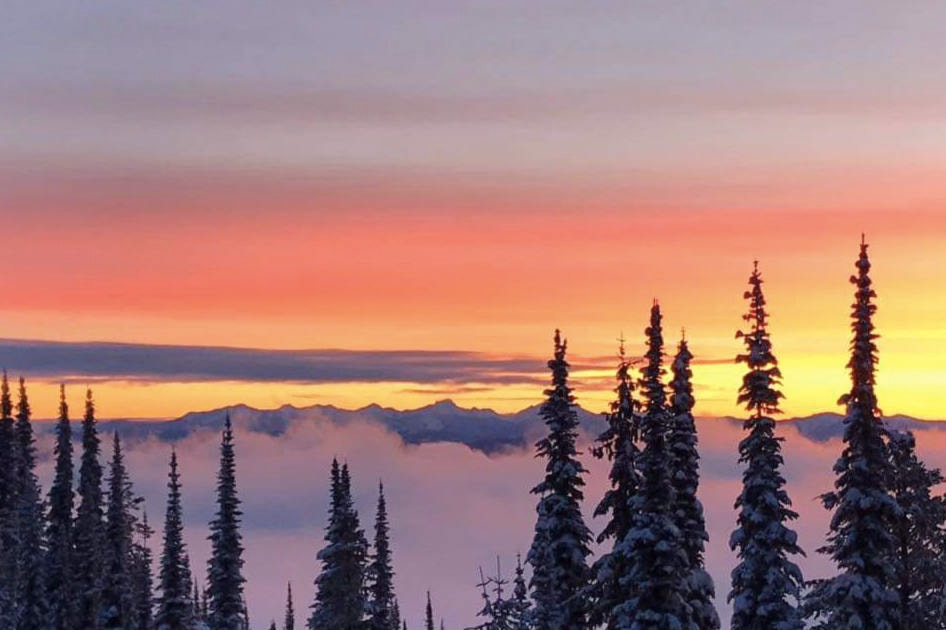I used to think November was a gloomy, chilly month. It’s a tricky time for outdoor activities. You have to move fast outside or stay cosy inside. It’s a great time to study clouds. They’re full of rain or snow, or just passing overhead and you can appreciate their dynamic nature through a window. Sunrises and sunsets can get quite bold now, too, if not fogged in.
Our hillsides, knolls and Silver Star offer the most remarkable cloud watching opportunities. You can see cloud masses move around the whole Okanagan, in fact, often all around but not over us.
Cloud watching suddenly opens a whole new window to nature appreciation. Children find funny, familiar shapes in clouds like castles, sheep, elephants and more. I even distinctly saw a huge bat shape one summer evening.
To understand clouds, and the processes that produce them, you need to understand air and weather which includes the dynamics of air movement, air pressure, humidity and temperature. Ask any sailor or pilot. They know this well.
READ MORE: Coldstream teacher hoops coach named to B.C. Sports Hall of Fame
All air contains water in the form of a gas called water vapour which has evaporated from sun-heated, ground-level water bodies; from bird baths to oceans. When water is warmed by the sun, water molecules are energized and move more, expanding the distances between them causing them to rise into the warm air. Vapour molecules attach onto tiny pieces of dust that are floating in the air and forms microscopic droplets around each dust particle. When billions of these droplets come together they reach the saturation point and become a visible cloud in the distance. As long as the cloud is warmer than the air around it, it floats! Air masses push the clouds along.
So a cloud is a massive collection of very tiny droplets of water vapour or ice crystals. They are so small and light that they can’t be seen as they float in the air. A cloud can contain both of these, depending on its temperature. For instance, a cloud’s top may be cooler than the lower regions, creating a mix of liquid and frozen water. Air pressure and humidity from the clouds and air temperature will dictate whether they rain or snow.
Eventually clouds cool at higher elevations. Cool air can’t hold as much water vapour as warm air. When cloud droplets collide and coalesce with others managing to attract enough water, gravity causes them to become falling raindrops.
Snow happens much like rain. As ice crystals condense and clump together in cold air, snowflakes form. When they reach the point where they’re too heavy to remain aloft, they fall together as snow. Different surrounding temperatures affect what type of snowflakes will develop. It can even snow in summer but may evaporate or melt into rain on the way down.
Clouds appear white because their water droplets or ice crystals are large enough to reflect and scatter the sunlight. If the clouds get thick enough, all the light above does not make it through, hence the grey or dark look. Also, other clouds around create shadows adding to the greyness.
Clouds at ground level are what we know as fog. It looks grey from inside and reduces visibility. Foggy weather is particularly common in the colder seasons. We’re familiar with these as temperature inversions when air pressure brings warm, moist air into the region trapping the dense colder air into the valley. If the valley air is near saturation, moisture will condense and form fog. Usually, the sun will be shining above all this and it distinctly looks like clouds filling the valleys as we drive down Silver Star.
Stay tuned for Part 2 on clouds in December.
Roseanne Van Ee enthusiastically shares her knowledge of the outdoors to help readers experience and enjoy nature. Discover exciting and adventurous natural events, best trails, and wild places. Follow her on Facebook for more.
READ MORE: Drivers urged to be careful as B.C. enters worst month for deer collisions
@VernonNews
newsroom@vernonmorningstar.com
Like us on Facebook and follow us on Twitter.
